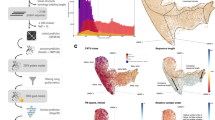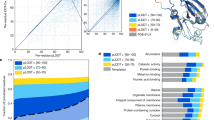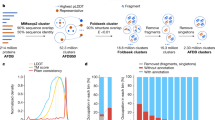Abstract
Determining a 'basis set' of protein folds that represent a majority of protein structures — making use of synchrotron radiation facilities — may be possible in the near future.
This is a preview of subscription content, access via your institution
Access options
Subscribe to this journal
Receive 12 print issues and online access
$189.00 per year
only $15.75 per issue
Buy this article
- Purchase on Springer Link
- Instant access to full article PDF
Prices may be subject to local taxes which are calculated during checkout

Similar content being viewed by others
References
Kerlavage, A.R. TIGR Microbial Genome Database. http://www.tigr.org/tdb/mdb/mdbcomplete.html (1998).
Abola, E.E., Prilusky, J. & Manning, N.O. Protein data bank archivesof three- dimensional macromolecular structures. Meth. Enz. 277, 556– 571 (1997).
Gerstein, M. & Levitt, M.A. Structural census of the current population of protein sequences. Proc. Natl. Acad. Sci. USA 94, 11911–11916 (1997).
Fischer, D. & Eisenberg, D. Assigning folds to the proteins encoded by the genome of Mycoplasma genitalium. Proc. Natl. Acad. Sci. USA 94, 11929–11934 (1997).
Boyd, D., Schierle, C. & Beckwith, J. How many membrane proteins are there? Prot. Sci. 7, 201–205 (1998).
Pascarella, S. & Argos, P. A databank merging related protein structures and sequences. Prot. Engng. 5, 121–137 (1992).
Orengo, C.A., Jones, D.T. & Thornton, J.M. Protein superfamilies and domain superfolds. Nature 372, 631–634 (1994).
Murzin, A., Brenner, S.E., Hubbard, T. & Chothia, C SCOP: A structural classification of proteins for the investigation of sequences and structures. J. Mol. Biol. 247, 536– 540 (1995).
Gibrat, J.F., Madej, T. & Bryant, S.H. Surprising similarities in structure comparison. Curr. Opin. Struct. Biol. 6, 377–385 (1996).
Holm, L. & Sander, C. Mapping the protein universe. Science 273, 595–602 (1996).
Schmidt, R., Gerstein, M. & Altman, R. LPFC: an internet library of protein family core structures. Prot. Sci. 6, 246–248 (1997).
Brenner, S.E., Chothia, C. & Hubbard, T.J. Population statistics of protein structures: lessons from structural classifications. Curr. Opin. Struct. Biol. 7, 369–376 (1997).
Hendrickson, W. and Ogata, C. Phase determination from multiwavelength anomalous diffraction measurements. Meth. Enz. 276,494–523 (1997).
Author information
Authors and Affiliations
Rights and permissions
About this article
Cite this article
Kim, SH. Shining a light on structural genomics. Nat Struct Mol Biol 5 (Suppl 8), 643–645 (1998). https://doi.org/10.1038/1334
Issue Date:
DOI: https://doi.org/10.1038/1334
This article is cited by
-
Crystal structure of an ASCH protein from Zymomonas mobilis and its ribonuclease activity specific for single-stranded RNA
Scientific Reports (2017)
-
In silico prediction of structure and functions for some proteins of male-specific region of the human Y chromosome
Interdisciplinary Sciences: Computational Life Sciences (2013)
-
Automatic structure classification of small proteins using random forest
BMC Bioinformatics (2010)
-
Selective prediction of interaction sites in protein structures with THEMATICS
BMC Bioinformatics (2007)
-
Towards a comprehensive structural coverage of completed genomes: a structural genomics viewpoint
BMC Bioinformatics (2007)



